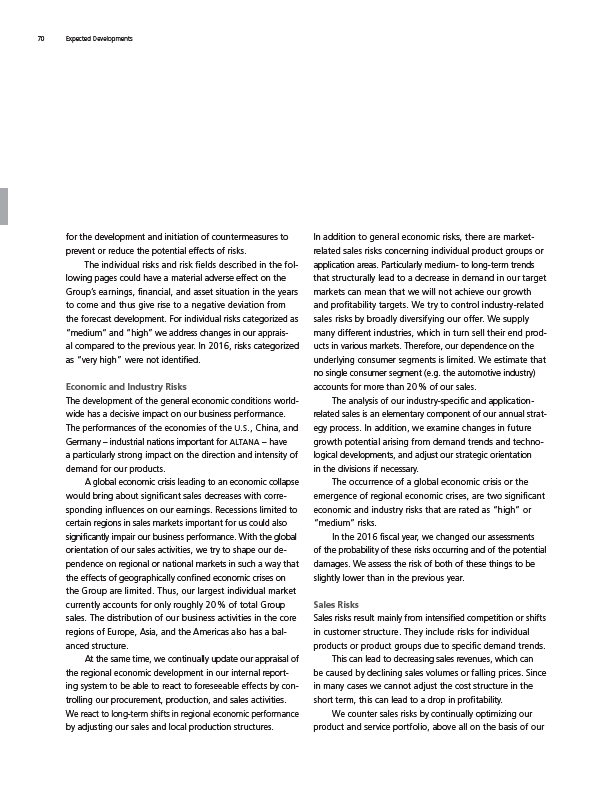
In addition to general economic risks, there are market-
related sales risks concerning individual product groups or
application areas. Particularly medium- to long-term trends
that structurally lead to a decrease in demand in our target
markets can mean that we will not achieve our growth
and profitability targets. We try to control industry-related
sales risks by broadly diversifying our offer. We supply
many different industries, which in turn sell their end products
in various markets. Therefore, our dependence on the
underlying consumer segments is limited. We estimate that
no single consumer segment (e.g. the automotive industry)
accounts for more than 20 % of our sales.
The analysis of our industry-specific and application-
related sales is an elementary component of our annual strat-
egy process. In addition, we examine changes in future
growth potential arising from demand trends and technological
developments, and adjust our strategic orientation
in the divisions if necessary.
The occurrence of a global economic crisis or the
emergence of regional economic crises, are two significant
economic and industry risks that are rated as “high” or
“medium” risks.
In the 2016 fiscal year, we changed our assessments
of the probability of these risks occurring and of the potential
damages. We assess the risk of both of these things to be
slightly lower than in the previous year.
Sales Risks
Sales risks result mainly from intensified competition or shifts
in customer structure. They include risks for individual
products or product groups due to specific demand trends.
This can lead to decreasing sales revenues, which can
be caused by declining sales volumes or falling prices. Since
in many cases we cannot adjust the cost structure in the
short term, this can lead to a drop in profitability.
We counter sales risks by continually optimizing our
product and service portfolio, above all on the basis of our
70 Expected Developments
for the development and initiation of countermeasures to
prevent or reduce the potential effects of risks.
The individual risks and risk fields described in the following
pages could have a material adverse effect on the
Group’s earnings, financial, and asset situation in the years
to come and thus give rise to a negative deviation from
the forecast development. For individual risks categorized as
“medium” and “high” we address changes in our apprais-
al compared to the previous year. In 2016, risks categorized
as “very high” were not identified.
Economic and Industry Risks
The development of the general economic conditions world-
wide has a decisive impact on our business performance.
The performances of the economies of the U.S., China, and
Germany – industrial nations important for ALTANA – have
a particularly strong impact on the direction and intensity of
demand for our products.
A global economic crisis leading to an economic collapse
would bring about significant sales decreases with corresponding
influences on our earnings. Recessions limited to
certain regions in sales markets important for us could also
significantly impair our business performance. With the global
orientation of our sales activities, we try to shape our dependence
on regional or national markets in such a way that
the effects of geographically confined economic crises on
the Group are limited. Thus, our largest individual market
currently accounts for only roughly 20 % of total Group
sales. The distribution of our business activities in the core
regions of Europe, Asia, and the Americas also has a balanced
structure.
At the same time, we continually update our appraisal of
the regional economic development in our internal report-
ing system to be able to react to foreseeable effects by controlling
our procurement, production, and sales activities.
We react to long-term shifts in regional economic performance
by adjusting our sales and local production structures.